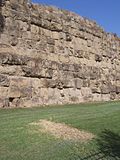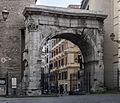 | An agger (Latin) is an ancient Roman linear mound or embankment. The word is sometimes applied to fortifications, such as the Agger Servianus, a part of... 6 KB (768 words) - 01:47, 6 July 2023 |
Agger may refer to: Agger (surname) Agger (ancient Rome), a type of ancient Roman rampart or embankment Agger (river), a river in North Rhine-Westphalia... 462 bytes (90 words) - 23:40, 13 June 2020 |
 | Roman roads (redirect from Roads in ancient Rome) Devana Watling Street Ancient Rome portal Historic roads and trails Legacy of the Roman Empire Roman military engineering Ancient Roman technology Forbes... 62 KB (7,654 words) - 15:17, 15 April 2024 |
 | Ardea, Lazio (category Municipalities of the Metropolitan City of Rome Capital) Ardea is an ancient town and comune (municipality) in the Metropolitan City of Rome Capital, 35 kilometres (22 miles) south of Rome and about 4 kilometres... 8 KB (745 words) - 10:35, 22 March 2024 |
 | Servian Wall (category Tourist attractions in Rome) this gate when he considered besieging Rome in 211 BC. This section was fortified additionally with the agger. Porta Viminalis – on the Viminal. This... 14 KB (1,561 words) - 23:29, 1 April 2024 |
 | Gardens of Maecenas (category Ancient gardens in Rome) villa, buildings, and gardens were located on the Esquiline Hill, atop the agger of the Servian Wall and its adjoining necropolis, as well as near the Horti... 25 KB (2,839 words) - 17:44, 1 January 2024 |
 | Pompeii (category Museums of ancient Rome in Italy) a large agger, or earth embankment, behind it. After the Samnite Wars from 290 BC, Pompeii was forced to accept the status of socii of Rome, maintaining... 94 KB (10,633 words) - 09:43, 16 April 2024 |
 | Baths of Diocletian (category Ancient Roman baths in Rome) northeast summit of the Viminal, the smallest of the Seven hills of Rome, just inside the Agger of the Servian Wall (near what are today the Piazza della Repubblica... 25 KB (2,830 words) - 23:34, 10 March 2024 |
property. Horti Liciniani The Horti Liciniani were a set of gardens in ancient Rome, which originally belonged to the gens Licinia. In the third century... 14 KB (1,927 words) - 00:19, 28 December 2023 |
 | Porta Viminale (Porta Viminalis) was a gateway in the Servian Wall of ancient Rome, at the centre of the most exposed stretch of the wall between the Porta... 4 KB (552 words) - 21:08, 1 January 2024 |
 | Gardens of Maecenas. Connecting northward to the Esquiline Gate was the agger, the heavily fortified section of the Servian Wall. Just southwest of the... 7 KB (933 words) - 01:02, 15 August 2023 |
 | Porta Caelimontana and Porta Querquetulana (category Gates of Rome) connected the gates to each other - that is, the 1,300 metres (4,300 ft) long agger between Porta Collina and Porta Esquilina - also dates back to the same... 8 KB (832 words) - 13:17, 11 April 2024 |
Castra (category Articles containing Ancient Greek (to 1453)-language text) guarding the praetorium. Ancient Rome portal Fortification Military history of ancient Rome Roman legion Outline of ancient Rome A 2nd declension neuter... 53 KB (6,645 words) - 10:33, 2 April 2024 |
Campus Esquilinus (category Topography of the ancient city of Rome) Campus Esquilinus was an area on the Esquiline Hill in ancient Rome. It was the site of many extravagant buildings as well as baths and gardens. The Campus... 4 KB (541 words) - 13:49, 30 October 2022 |
 | Castellum (category Ancient Roman military stubs) v t e Fortifications Ancient Abatis Acropolis Agger Broch Burgus Castellum Castra Castros Circular rampart City gate Crannog Ditch Defensive wall Dun Faussebraye... 1 KB (90 words) - 00:48, 12 April 2024 |
The son of Zeus and Hera, he was worshiped as the god of war in ancient Greece and Rome. Ares' dissatisfaction with Zeus' rule of Olympus began after Zeus'... 13 KB (1,783 words) - 22:53, 31 March 2024 |
 | Roman army of the mid-Republic (category Military of ancient Rome) (fossa) would be excavated, and the spoil used to build an earthen rampart (agger) on the inside of the ditch. On top of the rampart was erected a palisade... 85 KB (12,003 words) - 01:17, 26 February 2024 |
a Roman camp. The vallum usually comprised an earthen or turf rampart (Agger) with a wooden palisade on top, with a deep outer ditch (fossa). The name... 6 KB (873 words) - 01:39, 14 March 2023 |
 | Imperial Roman army (category Military of ancient Rome) (fossa) would be excavated, and the spoil used to build an earthen rampart (agger) on the inside of the ditch. On top of the rampart was erected a palisade... 214 KB (28,725 words) - 19:54, 27 February 2024 |










